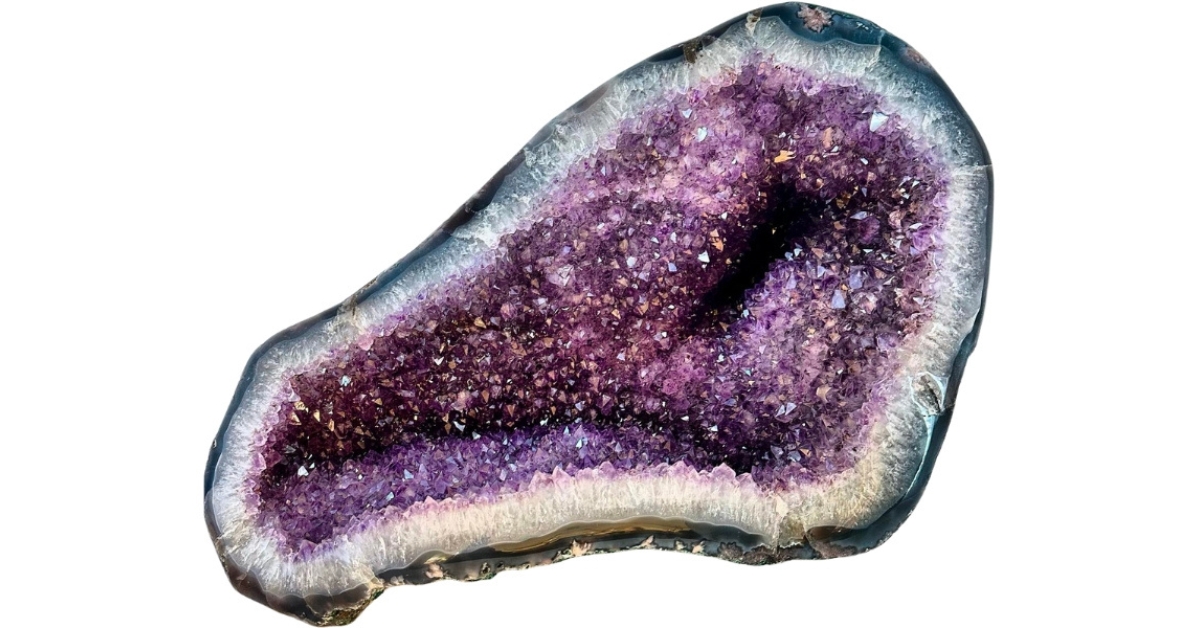At first glance, a geode seems like a plain, round, and ordinary rock. But once you crack it open, you’ll discover a treasure trove of sparkling crystals inside!
It starts as bubbles in volcanic rock or as animal burrows, tree roots, or mud balls in sedimentary rock. Over millions of years, minerals seep in and crystals grow slowly inside the hollow space.
Did you know that there are many different types of geodes out there? They come in many shapes and sizes, and when you slice them open, they reveal shiny, often colorful crystals pointing inward.
Join us as we explore the different geode types, get a view of what these geodes look like, and understand what makes each of them special. By the end of this article, you may have a renewed interest in geodes and all its beautiful types.
The 26 Different Types Of Geodes And What They Look Like
The value of a geode isn’t just in how it sparkles or the colors it shows but in the excitement of cracking it open to see what’s inside. By exploring its different types, you’ll better appreciate just how valuable this natural treasure is.
Clear Quartz Geode
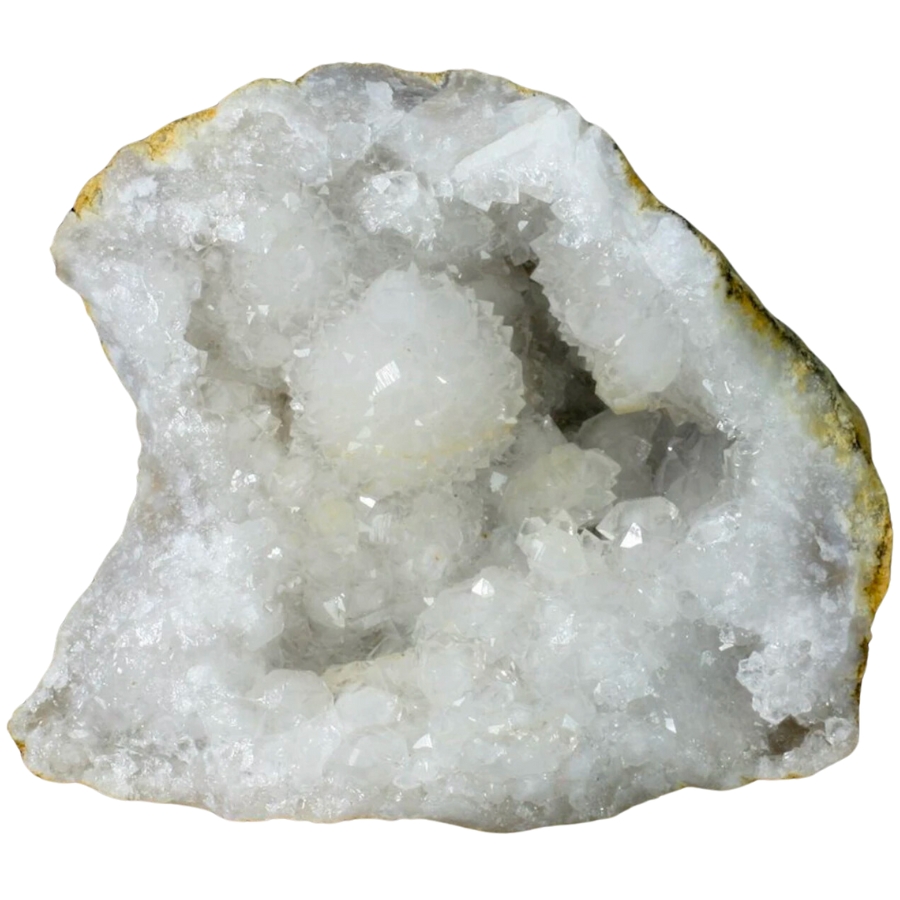
Clear quartz geodes are filled with shimmering, translucent crystals that catch the light in the most magical way. They are incredibly popular among rockhounds for their beauty and the pure, serene vibe they bring.
Clear quartz, also known as rock crystal, forms stunning, hexagonal crystals that can be either small and sparkly or large and commanding. Some are completely filled with crystals, while others have a hollow center, creating a sparkly little cave.
The value of quartz is influenced by how well-loved it is by many. They come in all sizes, too, from small enough to fit in your palm to as big as a person. The insides might be lined with fine, druzy crystals or feature larger, more defined points.
Where you can find clear quartz geode
You’ll often find clear quartz geodes in places with a history of volcanic activity. Brazil is famous for its spectacular specimens, but you can also find them in areas like Morocco, Mexico, and the USA.
If you need more information on where to find geodes, check out our article on that.
DON'T MISS OUT ON ANY GREAT FINDS!
While you're out searching you're going to find A LOT of other interesting rocks and minerals along the way. The last thing you want to do is toss out something really interesting or valuable. It can be easy to misidentify things without a little guidance.
You absolutely need a good reference guide in order to understand what you're looking at!
We've put together a fantastic field guide that makes identifying 140 of the most interesting and valuable rocks and minerals you will find REALLY EASY. It's simple to use, really durable, and will allow you to identify just about any rock and mineral you come across. Make sure you bring it along on your hunt!
Now, back to the identification specifics:
Smoky Quartz Geode
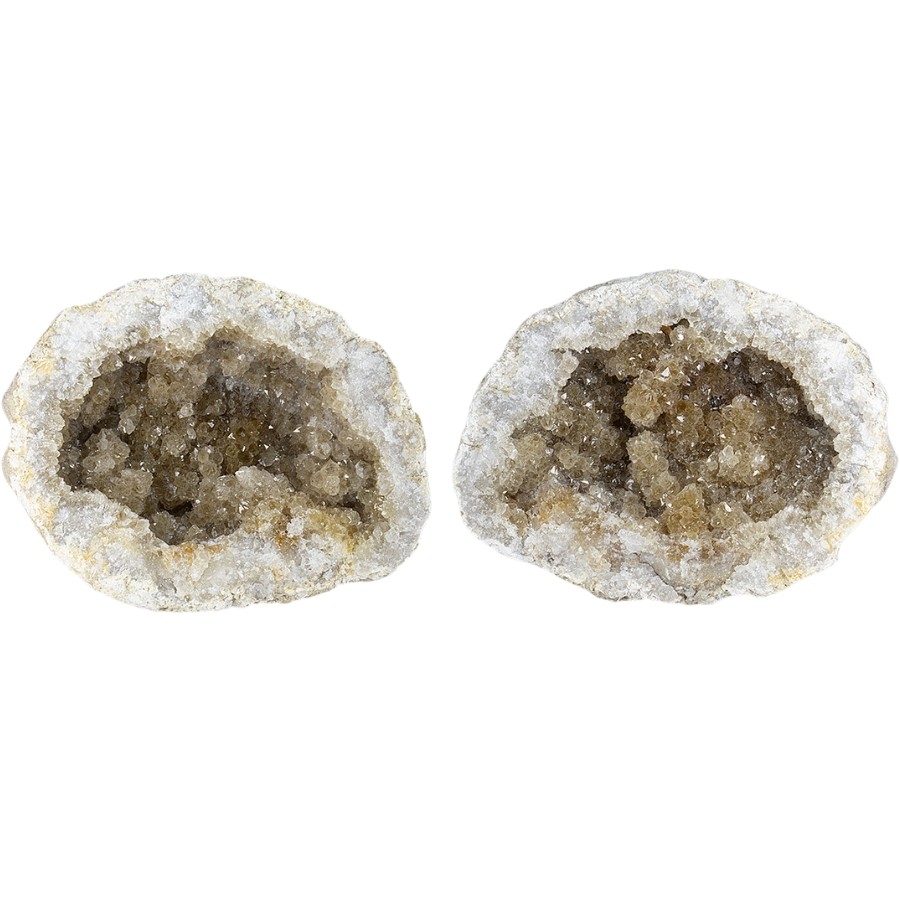
Smoky quartz geodes have a mysterious vibe, thanks to their dark, smoky crystals. It gets its intriguing color from natural radiation, which turns it from clear to a range of browns, from light and wispy to deep and intense.
What’s fascinating about smoky quartz geodes is the variety they offer. Some have a light, almost ethereal smokiness, while others are so dark they’re nearly black.
The crystals inside can vary too, from sharp, well-defined points to clusters of smaller, shimmering crystals. It’s this variety that keeps rockhounds coming back for more, as no two smoky quartz geodes are ever the same.
Where you can find smoky quartz geode
Smoky quartz geodes are found in places with the right conditions for quartz to capture the smoky color, like in several states in the USA. Brazil and Madagascar are also well-known for their stunning smoky quartz geodes.
For more information on where to go rockhounding, you can refer to our article.
Rose Quartz Geode
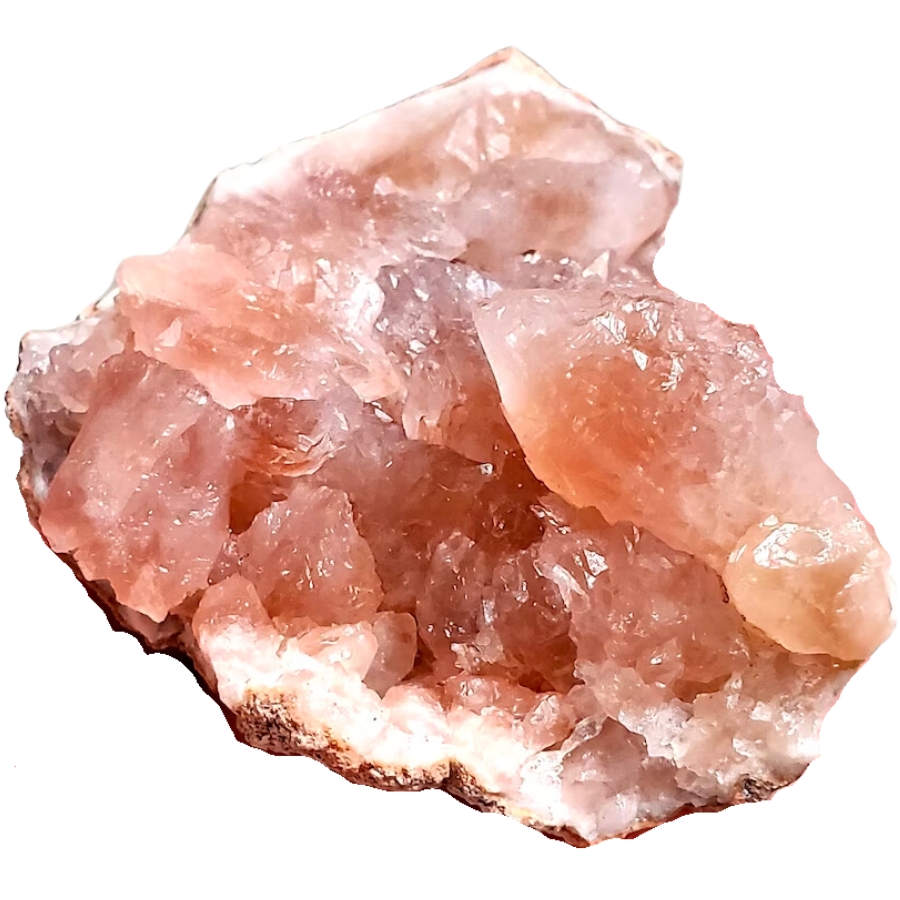
With their warm, gentle pink hues that seem to glow from within, rose quartz geodes are like a piece of the sunset in your hands. They’re filled with rose quartz, a crystal known for its soft, inviting color.
This type of quartz gets its lovely shade from trace amounts of titanium, iron, or manganese. They can range from a very pale, almost clear pink to a deeper, more vibrant shade.
In many cultures, rose quartz has been a symbol of love and healing. It’s often called the ‘love stone’ because people believe it promotes feelings of love, happiness, and emotional healing.
Where you can find rose quartz geode
You’ll often find rose quartz geodes in Brazil, which is famous for its rich variety of minerals. Madagascar and South Dakota in the USA are also known for these pink beauties.
Interested to know about the gem mines near you? Check this out!
Amethyst Geode
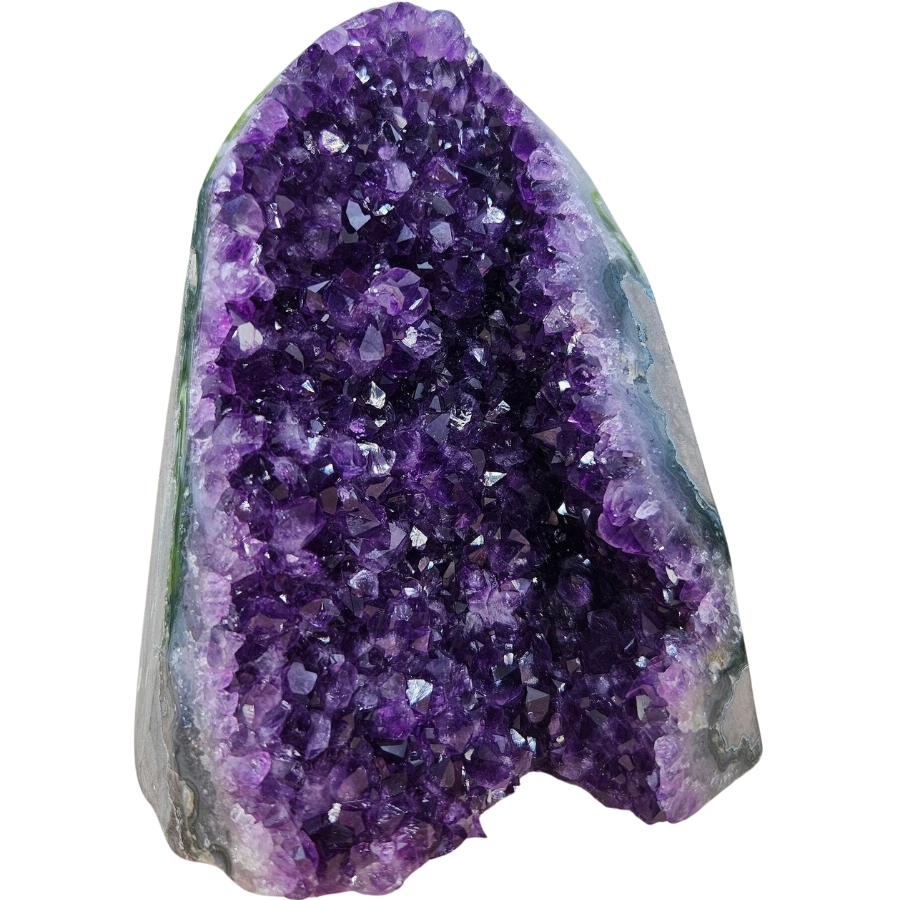
Amethyst geodes are filled with deep purple crystals that seem to sparkle and dance in the light. These geodes are super popular because of their stunning beauty and the rich color that ranges from light lavender to deep violet.
Its color comes from iron impurities and the natural radiation from the rocks around them. Each amethyst geode is distinct. Some are small enough to fit in your hand, while others can be as big as a person!
Inside, you might find tiny, delicate crystals or huge, jagged points. It’s this variety that makes each amethyst geode a special discovery.
For a long time, the price of amethyst goes more than just how it looks. Many believe it has calming and protective properties. It’s often called the ‘stone of peace’ and is used in jewelry, meditation, and decoration.
Where you can find amethyst geode
You’ll often find amethyst geodes in Brazil and Uruguay, which are famous for having some of the most beautiful specimens in the world. You can also find them in Mexico, Namibia, and even the USA.
To know more about where to find crystals like amethyst geodes here, check out our guide.
Calcite Geode
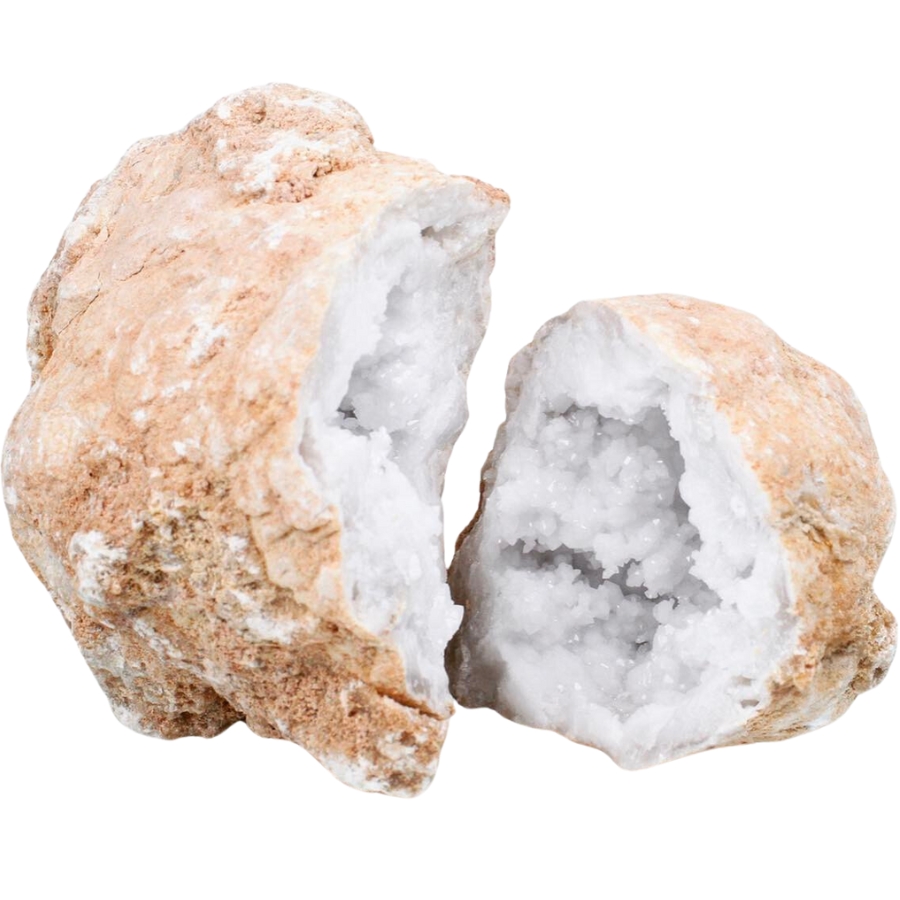
Calcite geodes are like hidden caves filled with sparkling treasures. They’re packed with calcite, a fascinating crystal that can be clear, white, or even full of vibrant colors like orange, pink, and green.
People have been fascinated by calcite for a long time because it has so many cool properties. For one, it can actually glow under ultraviolet light. It’s also used in a lot of everyday things like toothpaste and construction materials.
But beyond its practical uses, how much calcite is worth is due to simply how beautiful it is to look at and how it adds a delicate touch to any collection.
Where you can find calcite geode
You’ll often find calcite geodes in places where there’s been a lot of water activity, like old riverbeds and hot springs. Mexico is a hotspot for these colorful beauties, but you can also find them in Iceland, the USA, and Brazil.
Celestite Geode
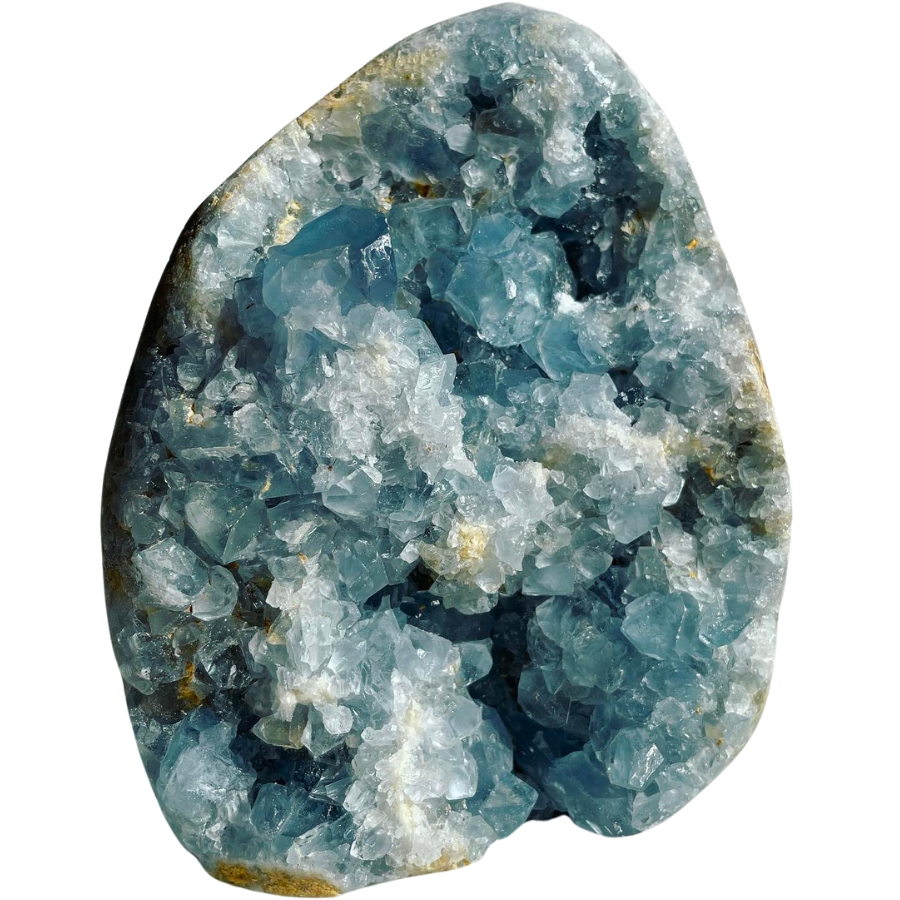
Celestite geode contains soft blue crystals that sparkle and shine. It got its name from the Latin word for ‘heavenly’, which makes perfect sense when you see its gentle, soothing color.
This geode seems to glow with an inner light. Its crystals can range from a very pale, almost clear blue to a deeper, more vibrant sky blue. It might be made up of tiny, delicate crystals or larger, more dramatic ones.
Besides their beauty, celestite crystals have a fascinating history. People have used them for centuries in jewelry and as decorative objects. Many also believe that it has calming and uplifting properties.
Where you can find celestite geode
Often, celestite geodes are found in places with ancient seabeds or salt deposits. Madagascar is known for its beautiful specimens, but you can also find them in Poland, Libya, and the USA, particularly in areas like Ohio and Michigan.
Agate Geode
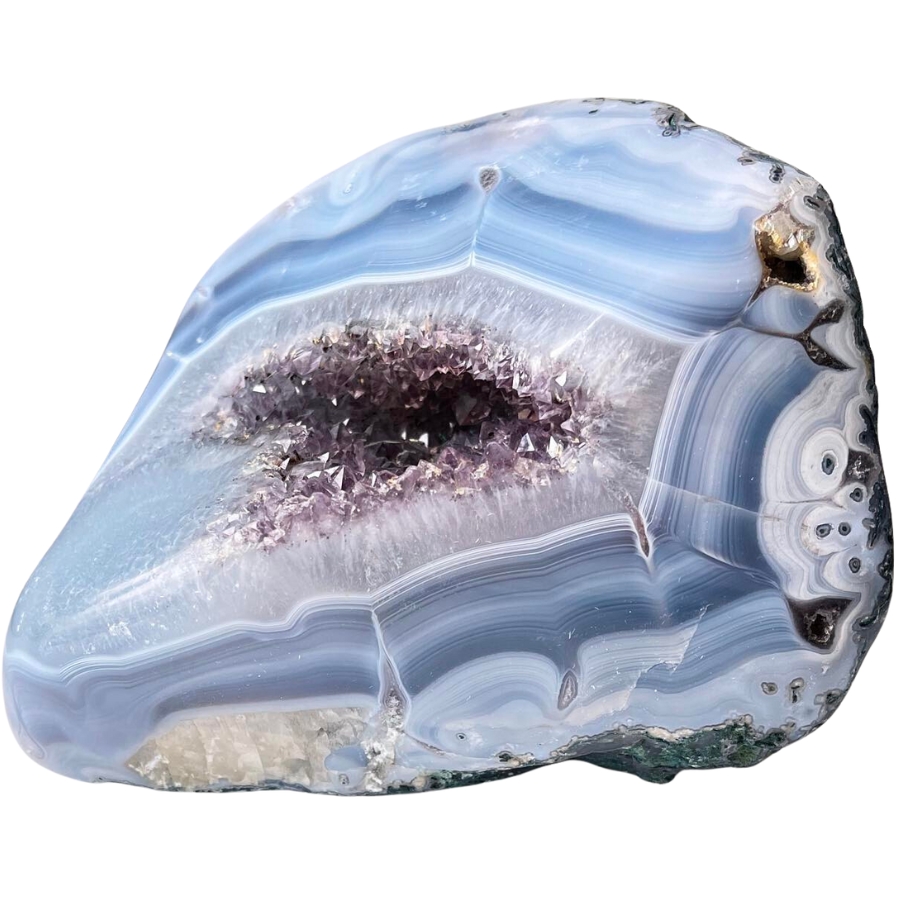
When you crack an agate geode open, it’s like entering a whole new world! It contains agate, a type of quartz that can show off a whole rainbow of colors.
The variety that it offers affects the price of agate geode. From the outside, they might look pretty ordinary, but inside, you’ll find incredible bands of colors like red, yellow, green, and blue.
Some even have patterns that look like waves or even landscapes. And did you know that some agate can even glow under UV light? Certain types can light up a bright green, making them even more awesome.
Where you can find agate geode
Agate geodes are found all over, but some of the most amazing ones come from Brazil and Uruguay.
You can also find them in the USA, Mexico, and Madagascar. These spots are great for agate geodes because they have just the right conditions for the agate to form its stunning layers.
Citrine Geode
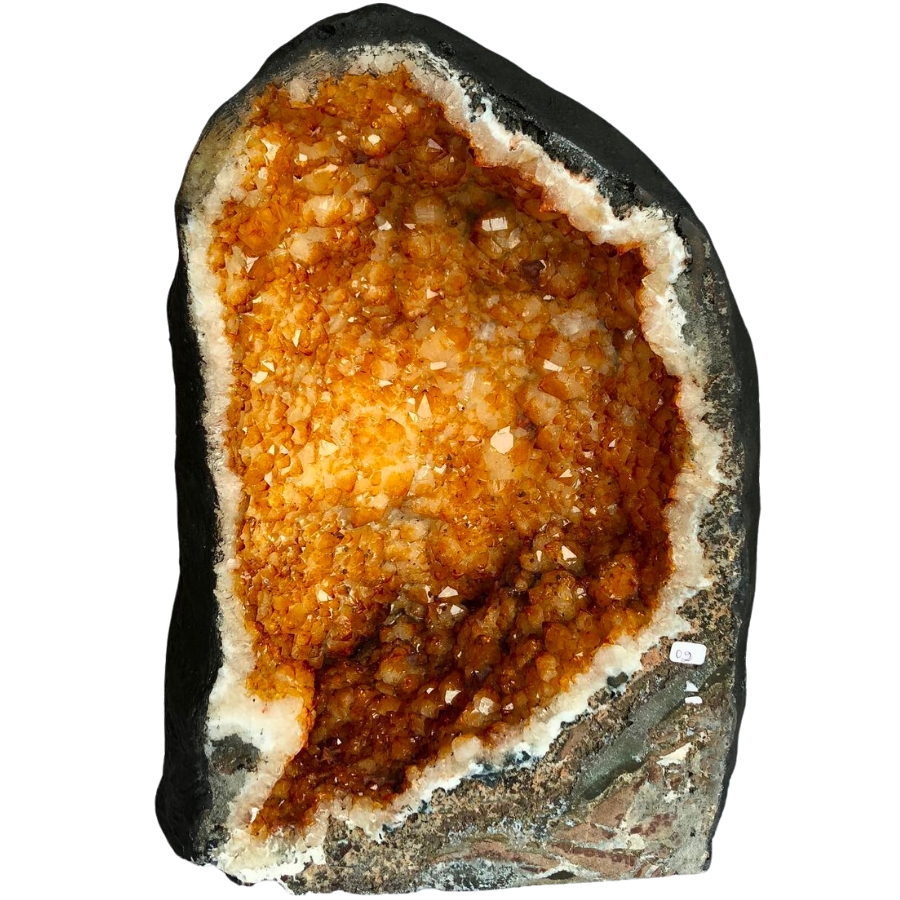
Citrine geodes are like little suns, glowing with warm, golden light. These geodes are filled with citrine, a type of quartz that ranges from a pale, lemony yellow to a deep, honey amber.
Most citrine starts as amethyst, another type of quartz, but when it’s heated, whether by nature’s underground heat or by people, it changes to the golden color we know and love.
Many people believe citrine brings joy, energy, and even wealth. It’s often called the ‘merchant’s stone’ because shopkeepers would keep it in their cash registers for good luck. There’s really no doubt if citrine is valuable or not.
Where you can find citrine geode
Many places bear natural citrine geodes, but some of the most beautiful ones come from Brazil. They’re also found in Madagascar, Russia, and even in the USA.
Pyrite Geode
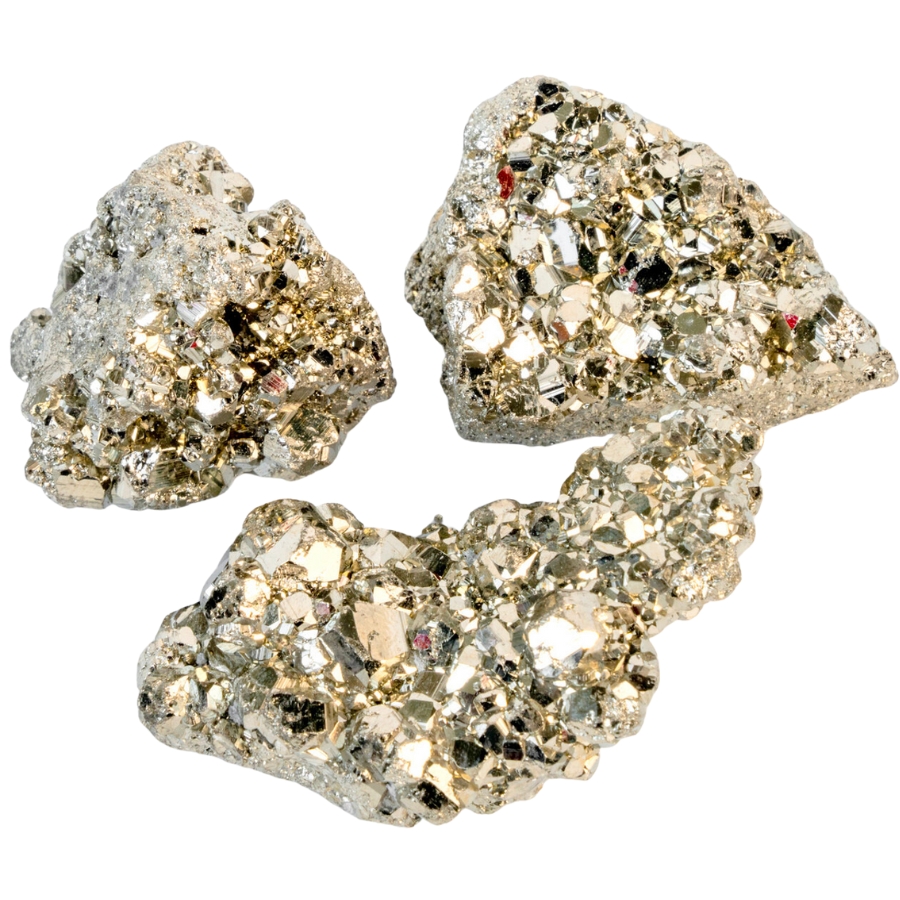
Pyrite geodes are like hidden vaults filled with golden treasures. They’re packed with pyrite, a mineral that’s also known as ‘fool’s gold’ because of its shiny, metallic appearance that looks a lot like real gold.
The pyrites in this type of geode can form in perfect cubes, clusters, or even round balls called ‘pyrite suns’. And when they catch the light, they glitter like real gold, which reflects the value of pyrite geodes.
Pyrite has a pretty interesting history. People have been mistaking it for gold for thousands of years, which is how it got its nickname. It’s been used in jewelry, and some people even believe it can attract wealth and good luck.
Where you can find pyrite geode
While you can find pyrite geodes in lots of places, they’re especially common in countries like Peru, Spain, and Italy. You can also find them in the USA, particularly in Illinois and Missouri.
Chalcedony Geode
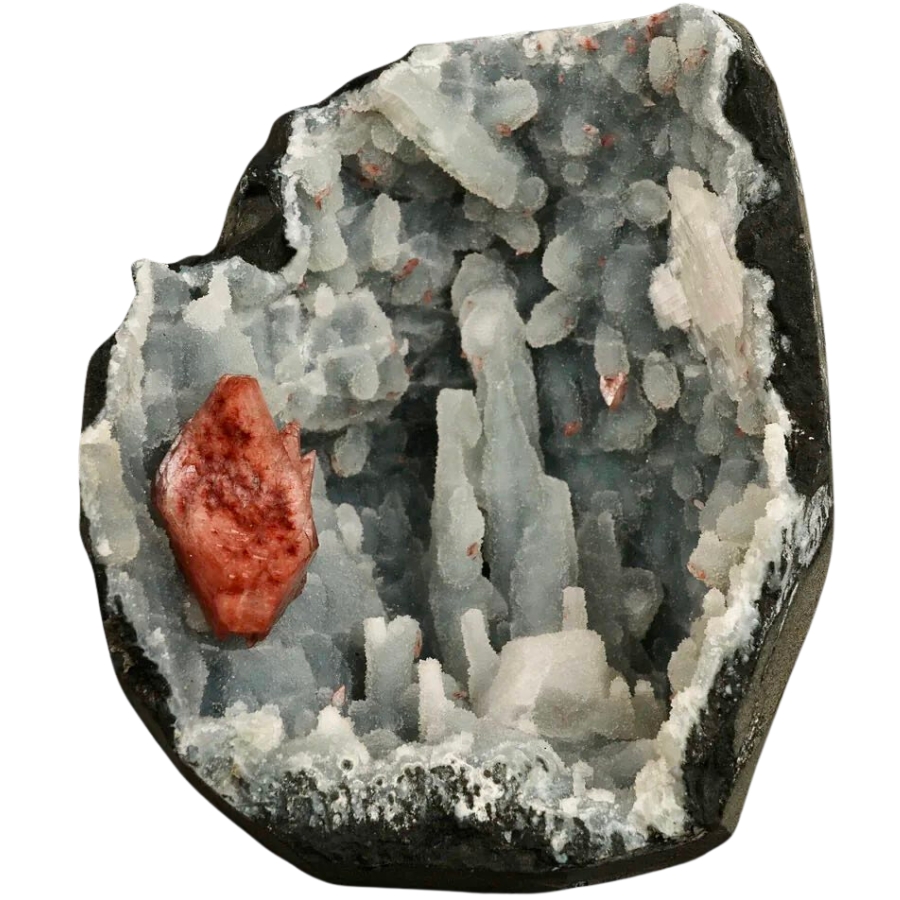
Chalcedony geode is packed with chalcedony, a form of quartz that’s known for its waxy luster. It can range from almost transparent to a milky opacity. Its soothing appearance makes it sought after by collectors.
Its colors can be pale and subtle, like blue, pink, or gray, or it might be a bit deeper and more striking. The way it forms can create patterns that look like landscapes or even waves. Sounds interesting, right?
Chalcedony has been used in all sorts of art and jewelry. Some even believe in the value of chalcedony geode to calm and soothe the mind.
Where you can find chalcedony geode
If you want to find chalcedony geodes, you should know that many places have them, but they’re particularly common in Brazil, India, and Madagascar.
You can also find them in the USA, especially in states like California, Arizona, and Oregon, so those are more options for your search.
Jasper Geode
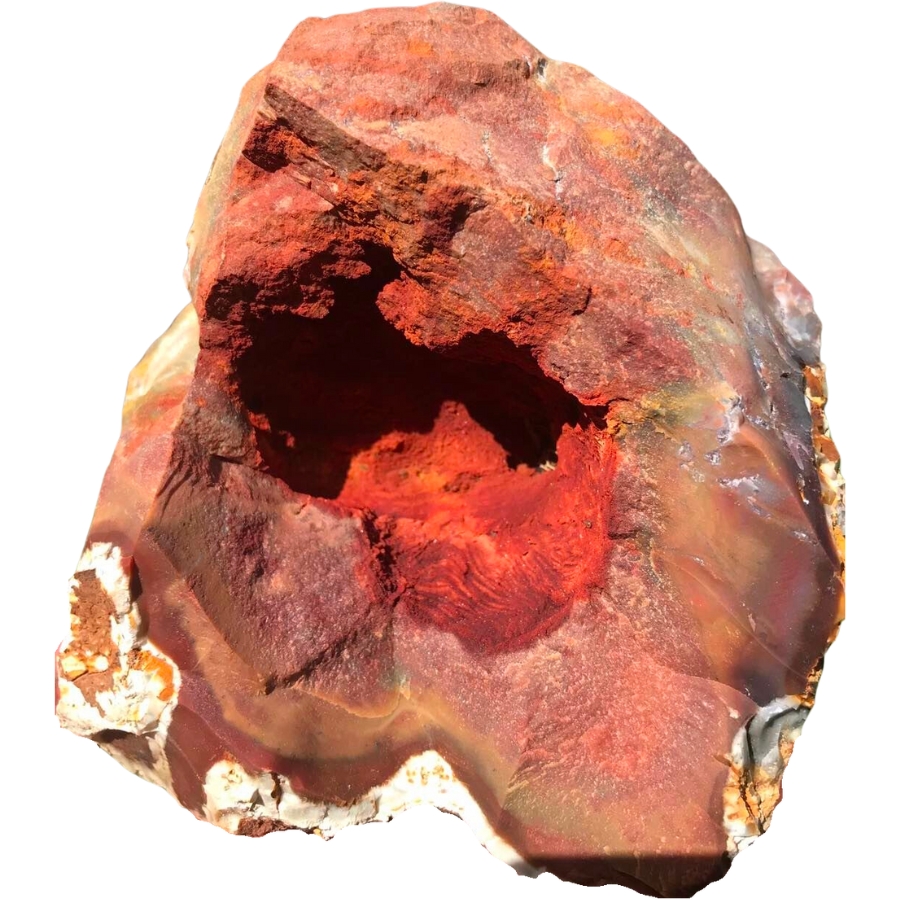
Jasper geodes contain jasper, which comes in almost every color you can think of. Finding one is like finding a natural piece of art, with swirls, spots, and stripes that make every piece unique.
Their huge variety of colors and patterns can mark up the price of jasper geodes. Some are bright red, others are deep green, and some even have multiple colors mixed together.
And the patterns can be just as varied, with stripes, spots, or even pictures that look like landscapes. It’s this variety that gave jasper a long history of being loved by people all over the world.
It’s been used for decoration, in jewelry, and even as a symbol of protection. Many believe that it has special powers, like bringing courage or calming the mind.
Where you can find jasper geode
You’ll find jasper geodes in lots of places. However, some of the most amazing ones come from Brazil, India, and the USA, which all have the perfect mix of minerals and conditions for jasper to form its beautiful patterns inside geodes.
Carnelian Geode
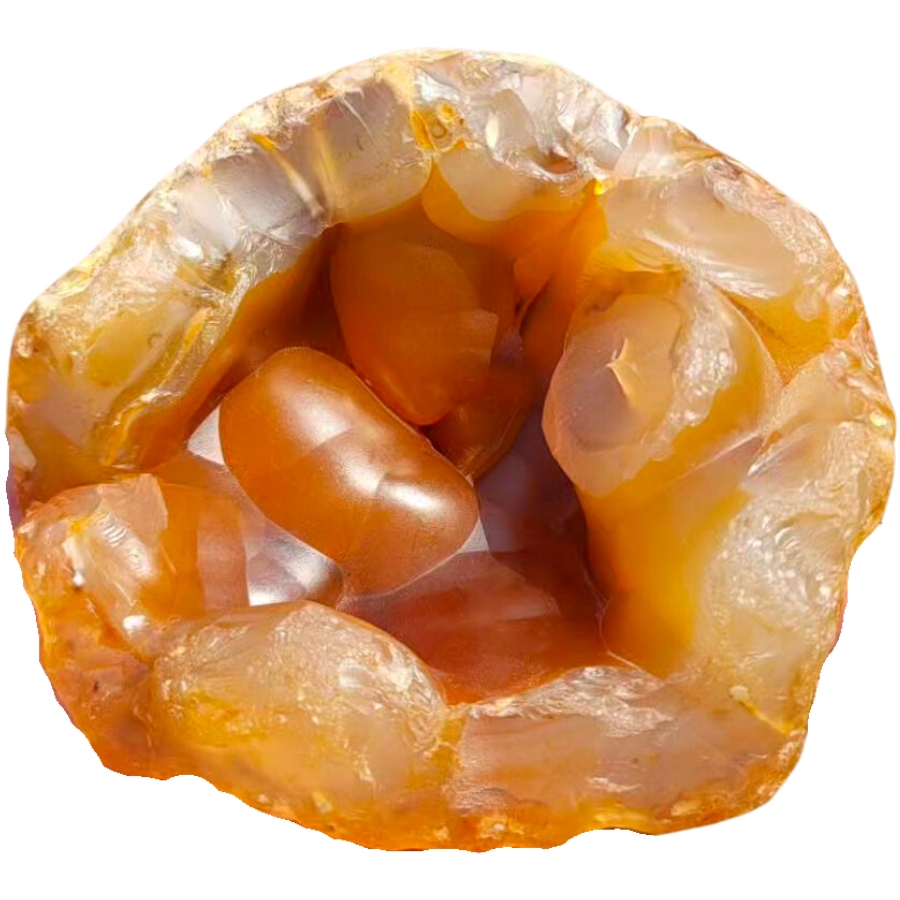
Carnelian geodes are like fiery sunsets captured in stone, with their warm, glowing reds and oranges that light up any room. Filled with carnelian, a type of quartz that’s known for its vibrant color, a carnelian geode is like a natural furnace.
Some are a soft, peachy orange, while others are a deep, fiery red. And just like other geodes, the inside might have tiny, sparkling crystals or larger, more dramatic ones. The beauty of these crystals contributes to the value of carnelian geodes.
Carnelian has a pretty cool history too. It’s been used for thousands of years in jewelry, carvings, and as a symbol of power and status. Many believe that it can boost courage, bring good luck, and even help people speak with confidence.
Where you can find carnelian geode
Although carnelian geodes are pretty widespread, some of the most striking ones come from India, Brazil, and Uruguay.
Selenite Geode
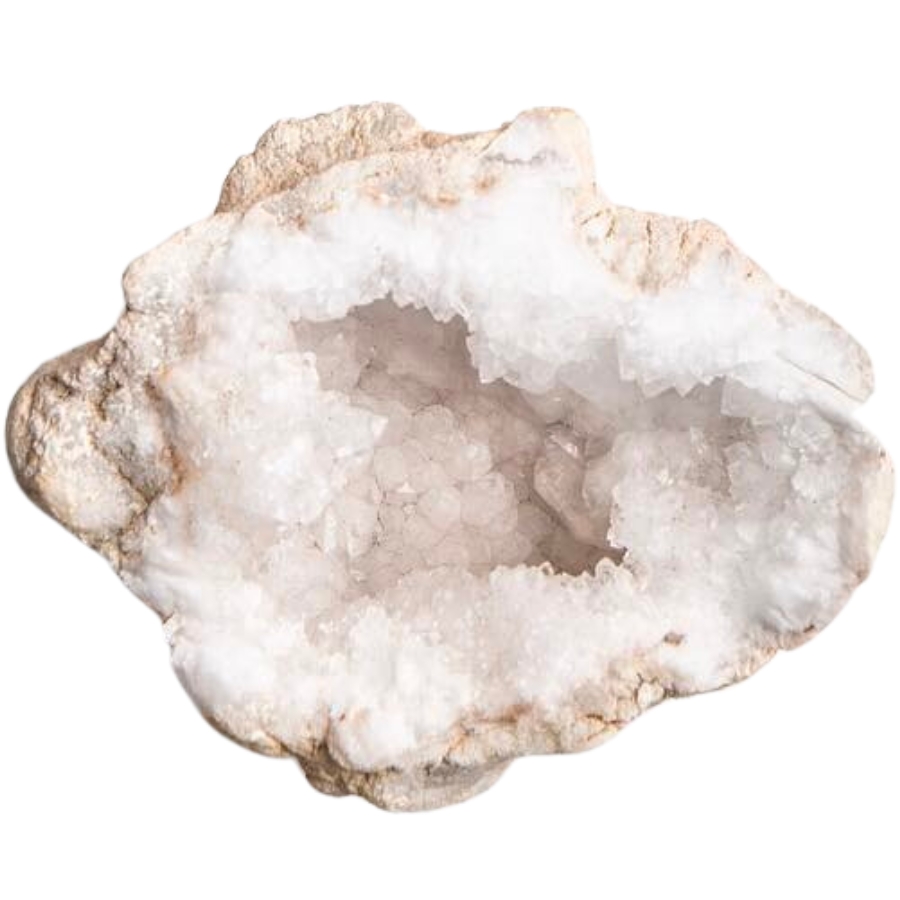
Selenite geodes are like moonbeams caught in stone, with their soft, milky glow and delicate crystals. Selenite is a type of gypsum that’s known for its clear, shimmery appearance.
When you see one, you’ll be amazed at how they seem to light up from within. The crystals can be long and thin, like swords of light, or they might form in delicate, flower-like clusters.
The value of selenite goes beyond its beauty. It’s been used for centuries in decorations and as a calming stone. Many believe that selenite has special powers like bringing peace, clarity, and protection.
Where you can find selenite geode
You can find selenite geodes in places where there are lots of evaporating water, like salt lakes and hot springs. One of the most famous spots for finding them is in Mexico, especially around the Cave of the Crystals.
You can also find them in Morocco, where they’re pulled from ancient dry lake beds. In the USA, places like Oklahoma are known for their beautiful selenite geodes.
Rhodochrosite Geode
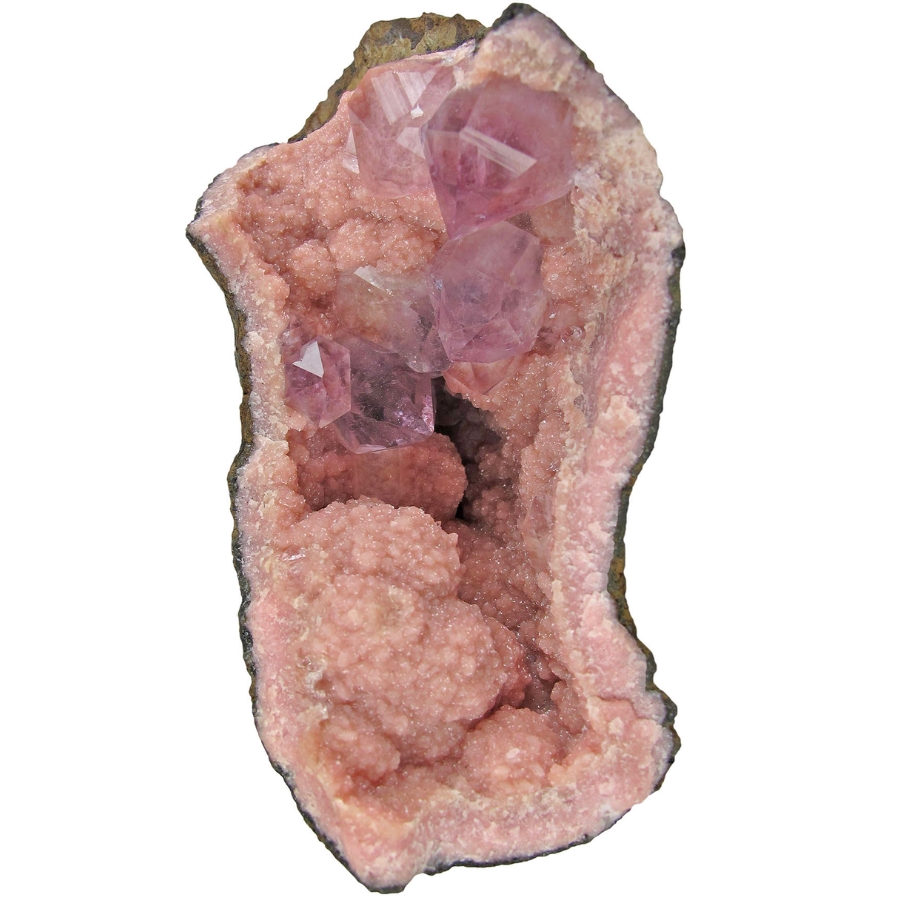
Filled with rhodochrosite, a mineral known for its rich, rosy hue, rhodochrosite geodes are like hidden bouquets of pink and red roses. Finding one is like uncovering a secret garden showing off shades of pink, red, and even creamy white.
The way the colors swirl and layer in rhodochrosite geodes makes it all the more interesting. Some have bands of different shades, while others might have patterns that look like flower petals.
Many also believe this geode has the power to help with emotional healing and love. It’s often called the ‘stone of the compassionate heart’ because of these beliefs.
Where you can find rhodochrosite geode
Argentina is known for having some of the best rhodochrosite geodes, especially from a place called the Capillitas Mine. But that’s not the only place you can find them.
Colorado, USA has some too, in a place called the Sweet Home Mine, where the rhodochrosite is so pretty it’s even called the ‘Alma Queen’.
South Africa and Romania are also spots where these lovely pink geodes like to hang out. Each place gives the rhodochrosite its own special look, making the hunt for them an exciting adventure.
Fluorite Geode
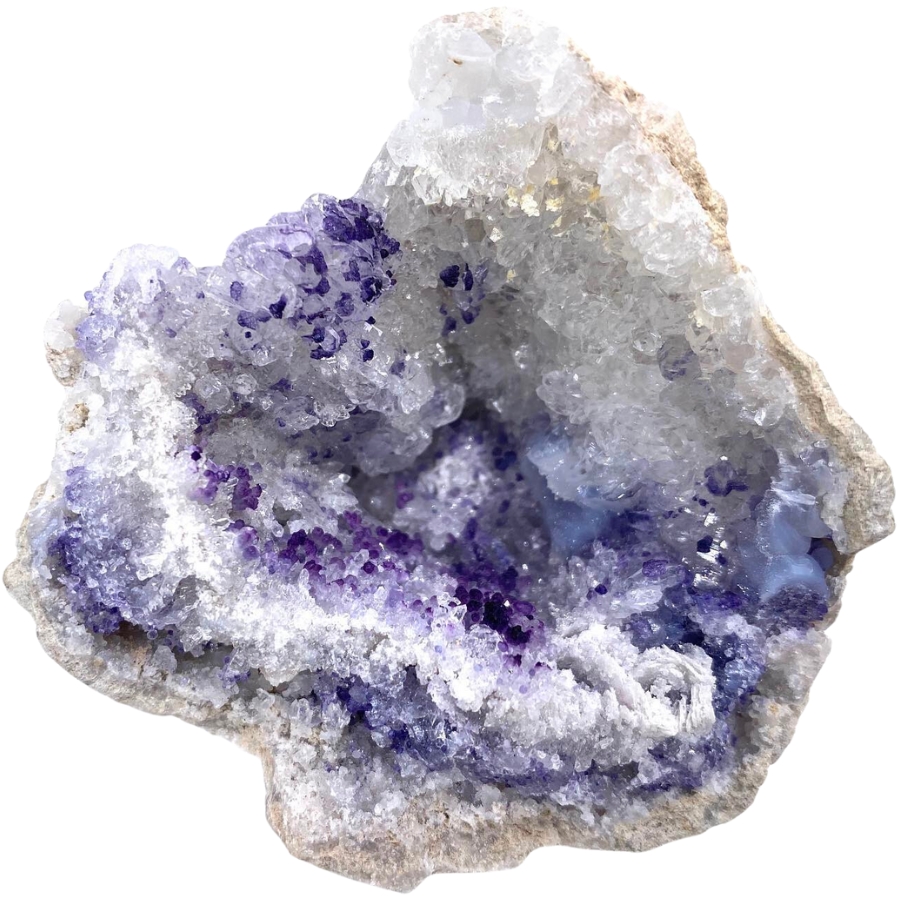
Fluorite geodes are like looking into a kaleidoscope, with all their cool colors and patterns. Fluorite is a mineral that can be just about any color of the rainbow.
Did you know that the colors of the fluorite inside this geode can change under different lights? Some fluorite can glow a bright blue or green when you shine a UV light on it.
And not only are they pretty to look at, but they also have some pretty neat uses. Fluorite is used in making things like lenses for cameras and telescopes because it’s so clear.
The price of fluorite geode can vary a lot, depending on many factors. But generally speaking, the more clear and colorful it is, the more it might cost.
Where you can find fluorite geode
One of the best spots to find fluorite geodes is in China. You can also find them in places like Mexico, where the fluorite comes in bright, beautiful colors. In the USA, states like Illinois and Kentucky are known for having fluorite too.
Stilbite Geode
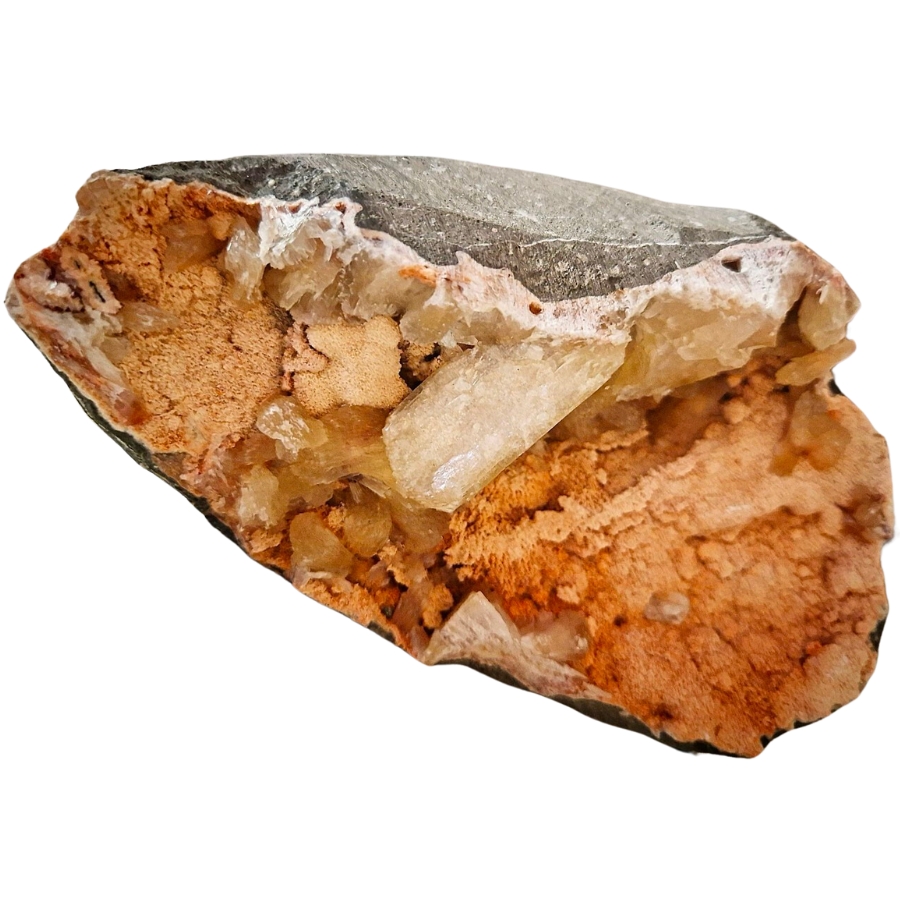
Stilbite geodes have soft, peachy pink, and sometimes clear or white crystals of stilbite, a part of the zeolite family.
The crystals inside this geode often grow in thin, flat plates or larger, more complex clusters that look like a bunch of flower petals. And because of their soft colors, they’ve got a gentle, soothing look.
Stilbite is also known for its ability to help with things like creativity and intuition. Some even believe it can help with sleep and calming the mind.
Another interesting thing about stilbite is that it’s often found with other minerals. So sometimes, when you find a stilbite geode, you might also see other cool minerals like apophyllite or calcite growing with it.
Where you can find stilbite geode
Stilbite geodes are found in some really interesting places. In India, you can find some of the most beautiful ones. You can also find them in Iceland and the USA, specifically in New Jersey and Oregon.
Scolecite Geode
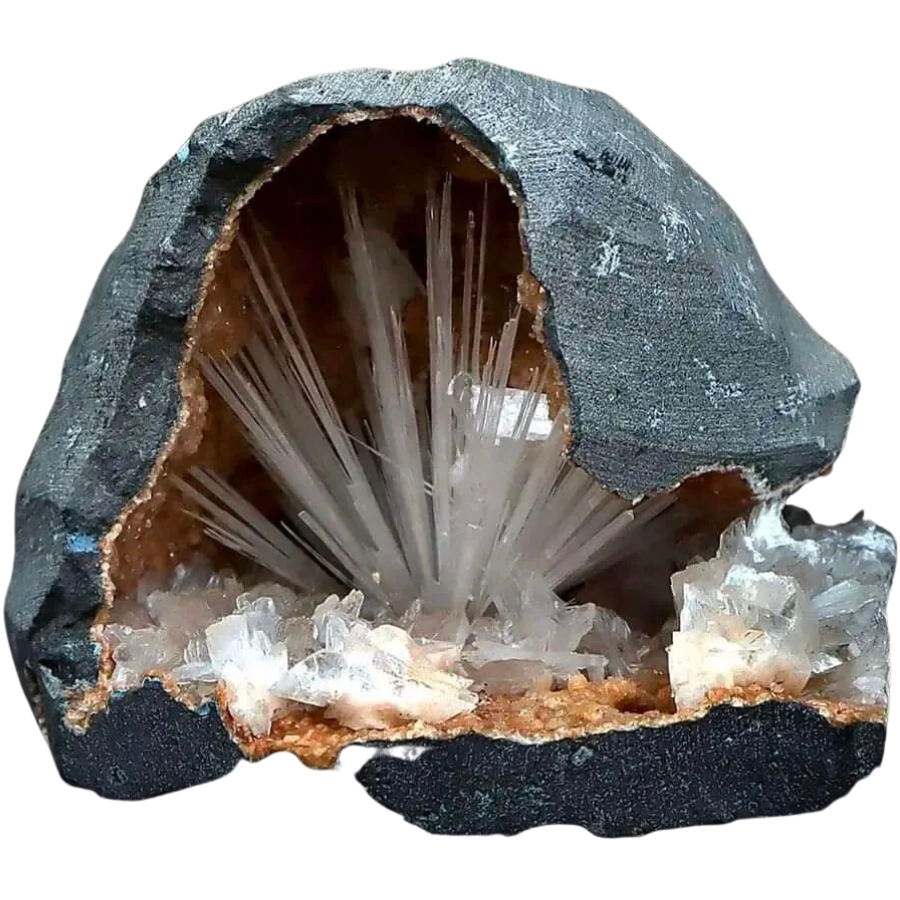
Scolecite geodes are like frozen fireworks, with their delicate, needle-like crystals that burst out in all directions. They contain scolecite, a mineral that’s known for its thin, long crystals and often pearly white color.
Scolecite crystals often form inside geodes in clusters that look like a bunch of white, spiky stars all gathered together. And because the crystals are so thin and fine, they sometimes seem to glow when the light hits them just right.
Despite its fragile appearance, scolecite crystals are pretty tough. They’re part of the zeolite family, minerals that are known for being strong and durable. So, even though it looks like it could break at any moment, it’s much stronger than it seems.
Where you can find scolecite geode
You can find amazing specimens of sparkly scolecite geodes in India and Iceland. In the USA, places like New Jersey are known for having this neat find, too.
Apophyllite Geode
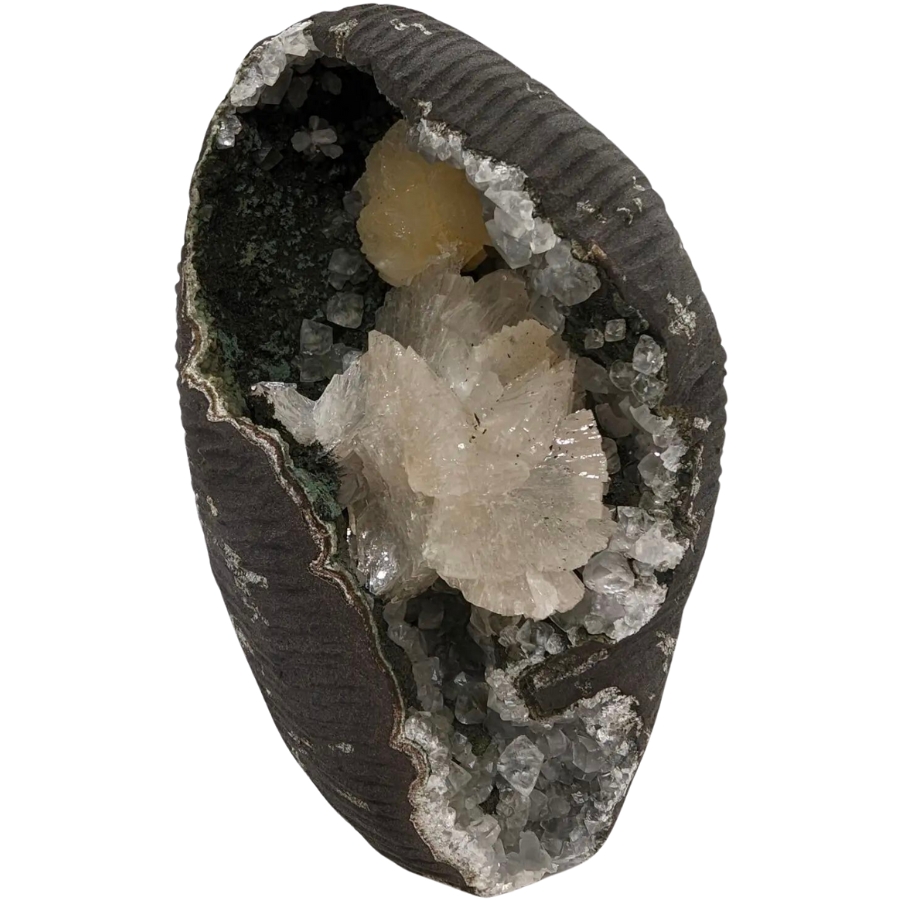
Apophyllite geodes are like mini crystal palaces, with their clear, sparkling crystals that catch the light in amazing ways. Apophyllite is known for its bright, shiny surfaces and often pyramid-like shapes.
Some crystals in apophyllite geodes are so clear they look like glass, while others might have a gentle green or pink hue. And because they often form in pointed shapes, they catch the light and sparkle from every angle.
Interestingly, apophyllite is one of the few minerals that can ‘flake’ when heated. This means that when it gets warm, thin layers can peel off like pages in a book. It’s a unique feature that makes it even more interesting.
Where you can find apophyllite geode
Apophyllite geodes are usually found in places where there’s been some volcanic activity. You can find them in India, Brazil, and the USA.
These spots are great because they have old lava flows and volcanic rocks, which are perfect for apophyllite to form its clear, sparkling crystals.
Aragonite Geode
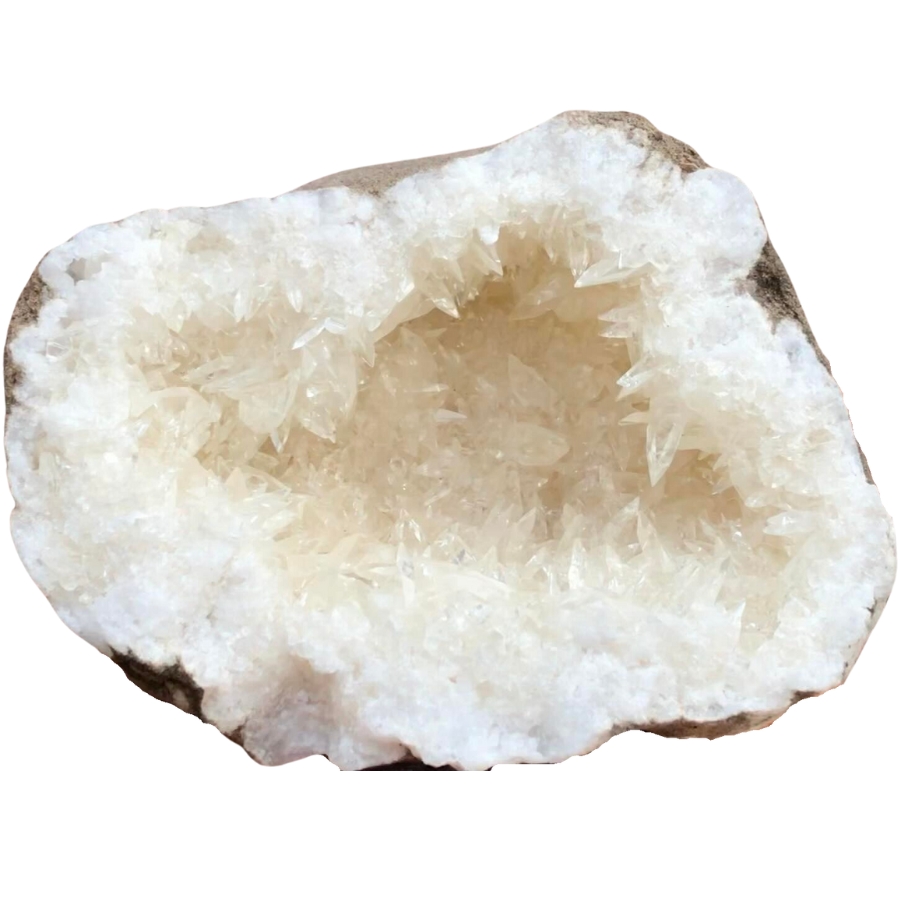
Aragonite geodes are like tiny, natural sculptures, each one full of spikes and twists that catch your eye. They’re made of aragonite, a mineral that forms in star-like clusters called ‘starbursts’.
Aragonite forms in a cool way. It often starts in places where there’s lots of water. As the water moves and evaporates, it leaves behind the minerals that build up into the spiky crystals we see in the geodes.
What makes aragonite geodes so distinct is their shape. The crystals don’t just grow in smooth, flat faces; they burst out in all directions, creating a wild and spiky look. This unique appearance is one reason why they’re so valued.
Where you can find aragonite geode
Aragonite geodes are usually found in places where water and minerals mix together. Some common spots are near hot springs and in caves, where dripping water leaves behind the minerals needed for the crystals to form.
Places like Morocco and Mexico are well-known for their beautiful aragonite geodes.
Septarian Geode
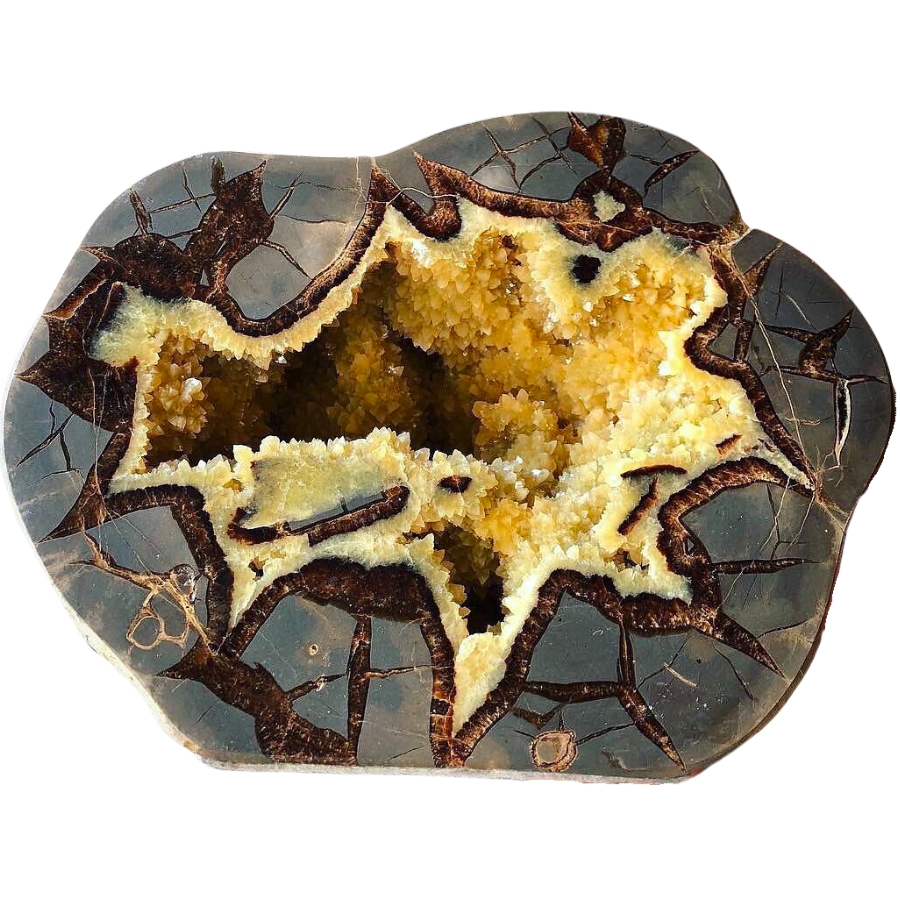
Septarian geodes are like natural puzzles, each one a mix of different minerals that come together in a unique way. They usually have a combination of yellow calcite, brown aragonite, and grey limestone.
Septarian geodes start as mud balls that crack as they dry out. Then, different minerals seep into the cracks and fill the spaces. This process creates the distinct look of septarian geodes, with their crackled patterns and mix of colors.
In fact, the name “septarian” comes from the Latin word “septum,” which means “partition” because of the way the minerals are separated into distinct sections.
The different minerals and the patterns in a septarian geode are like a record of what happened over thousands of years. This unique appearance is one reason why they’re so valued.
Where you can find septarian geode
You can find septarian geodes in places that used to be underwater, like old sea beds. In the USA, they’re uncovered in Utah and Nevada. You can also find them in Madagascar.
These locations had lots of mud that dried and cracked, which is the first step in making septarian geodes.
Malachite Geode
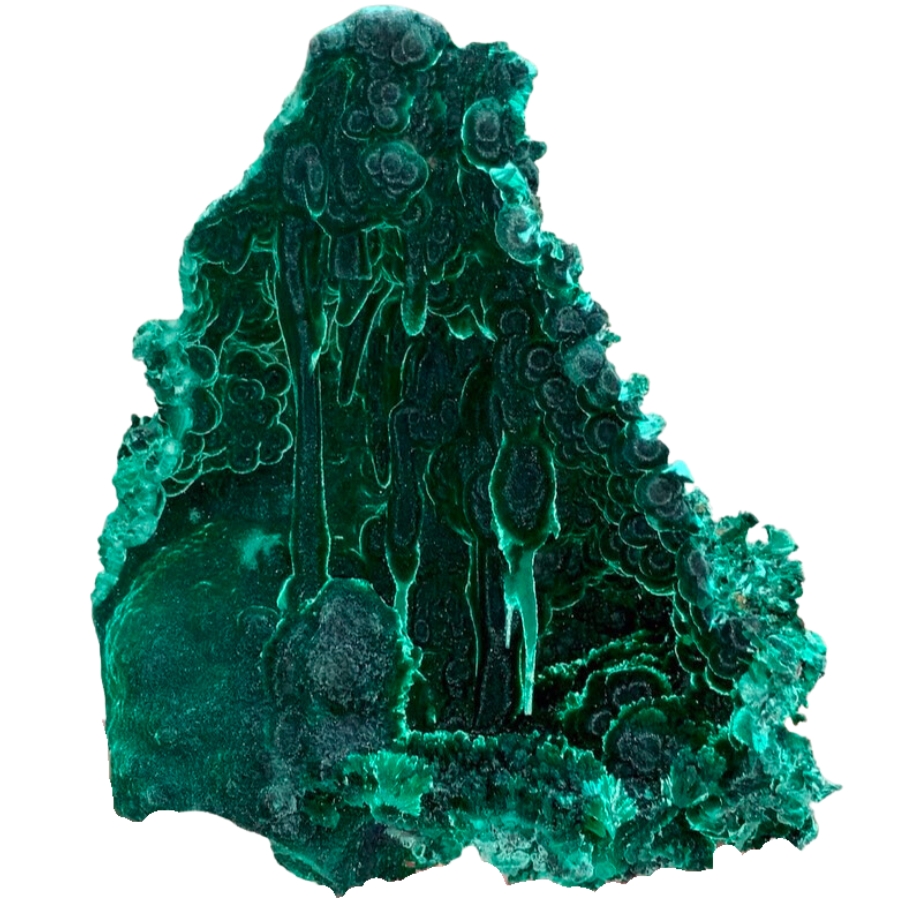
Malachite geodes have deep, vibrant green colors swirling in patterns that look like the rings of ancient trees. When you open one, it’s like peeking into a miniature forest, full of shades and stripes of green.
Malachite forms from copper deposits. As water moves through the copper, it picks up bits of the metal and other minerals. When the water evaporates, it leaves behind the beautiful green malachite.
The value of malachite comes from its striking beauty and its history. People have been drawn to its deep green color for thousands of years, using it in jewelry, decorations, and even as a pigment for paint.
In the past, some believed it could protect children from evil spirits and even help businessmen make good deals. It’s been a symbol of protection and power for a long time.
Where you can find malachite geode
Malachite geodes are usually found in places with lots of copper, because that’s where malachite comes from. A common spot for it is in the Congo. You can also find them in Russia and Australia.
Azurite Geode
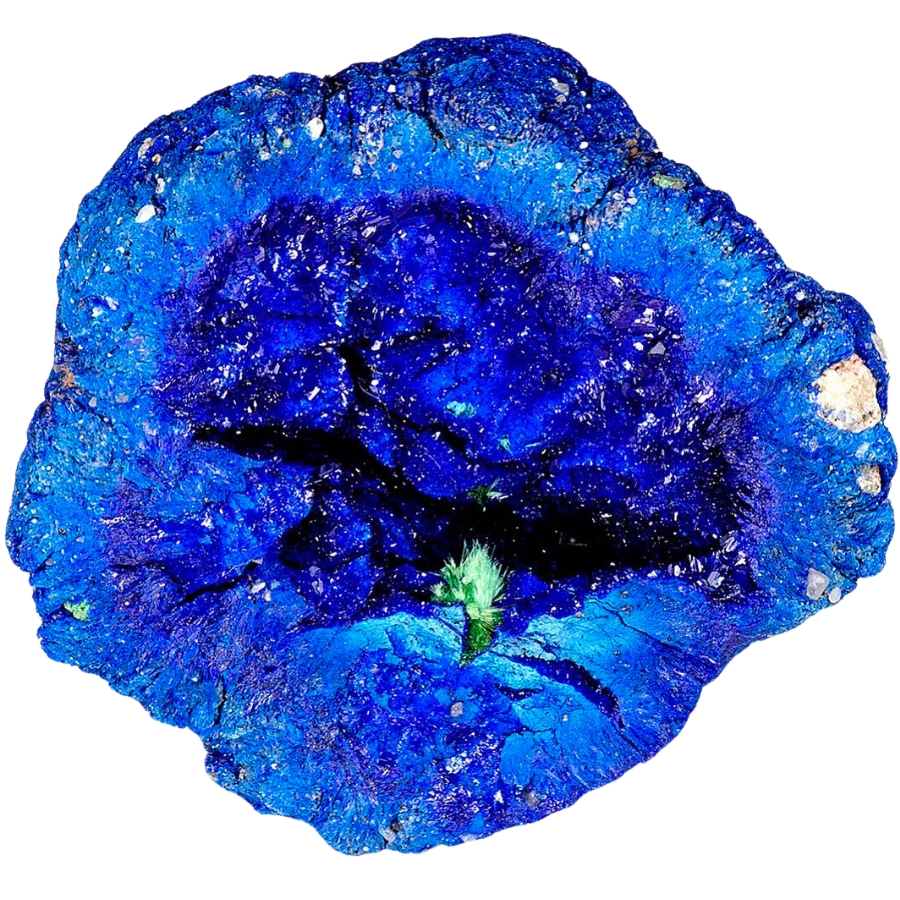
Azurite geodes are filled with stunning, deep blue-colored crystals. Opening one is like uncovering a drop of the ocean with different shades of blue that seem to dance and swirl inside.
Azurite starts to form with copper ore. As water moves through the copper, it picks up bits of the metal and other minerals. Over time, this mixture changes and turns into the beautiful blue azurite.
The deep blue color of azurite has been loved for centuries, used in jewelry, and even ground up as a pigment for paint. Its vivid blue color is so famous, it was used to create the bright blues in many Renaissance paintings.
Despite its hardness, it’s actually quite fragile and can slowly change into another mineral called malachite over time. This transformation is a cool example of how minerals can change right before our eyes.
Where you can find azurite geode
Azurite geodes are usually found in places with lots of copper. You can find these deep blue rocks in the USA, especially in Arizona and Utah. You can also find them in Mexico and France, where the conditions are just right for them to grow.
Prehnite Geode
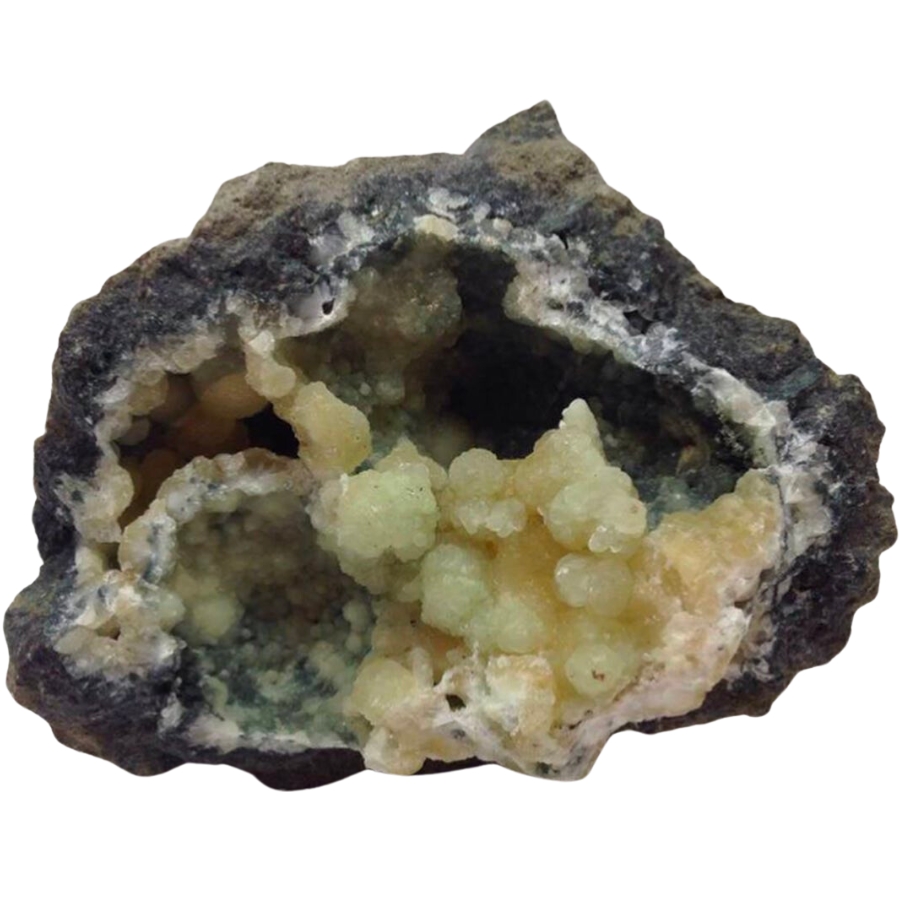
Prehnite geodes are like little globes of soft green light. Sometimes, its crystals inside can also be clear or yellow.
Prehnite usually grows in the spaces between rocks, where it’s cool and there’s a lot of water. Over time, as the water moves through these spaces, it leaves behind minerals that slowly build up into beautiful prehnite crystals.
It’s been used in jewelry and as a gemstone for centuries because of its beauty. The calm, gentle color of prehnite is so beloved, that it’s often called the ‘stone of unconditional love.’
Prehnite was actually one of the first minerals to be named after a person. Its discoverer, a Dutch colonel named Hendrik von Prehn, is who it’s named after.
Where you can find prehnite geode
Prehnite geodes are usually found in Australia. You can also find them in places like South Africa and China, where the conditions are just right for them to grow.
These locations are special because they’ve got the right mix of minerals and water, which is perfect for prehnite to form its soft, green crystals.
Opal Geode
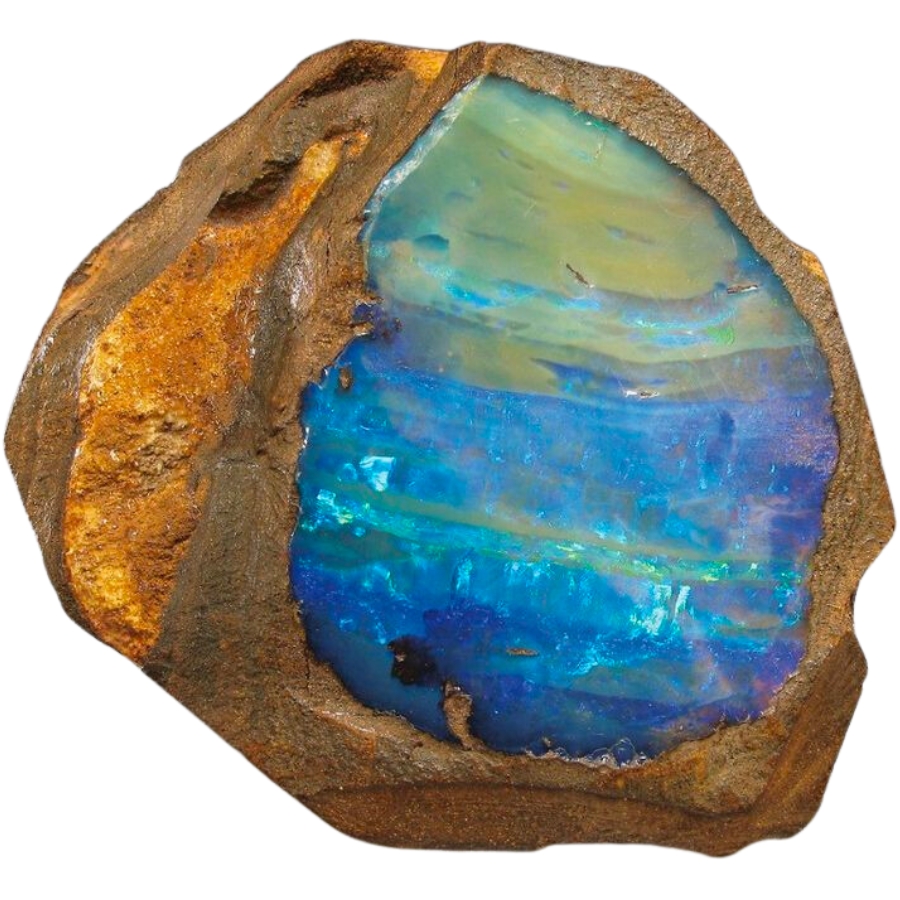
Opal geodes are filled with opals dazzling with their play of colors that can include blues, greens, pinks, and more.
Opal forms when water seeps into the ground, carrying silica with it. This silica-rich water fills up cracks and voids in rocks. As it evaporates, it leaves behind the silica, which slowly turns into the beautiful opal we see.
The value of opal geode comes from its stunning beauty and rarity. People have been drawn to its mesmerizing colors for centuries, using it in jewelry. The play of color in opal is so unique that it has its own name: opalescence.
And did you know that opal is Australia’s national gemstone? They even produce most of the world’s opal.
Where you can find opal geode
Opal geodes are usually found in places that have had a lot of volcanic activity. As we mentioned, Australia is known for its amazing opals. You can also find them in Brazil, Mexico, and the USA, especially in states like Nevada.
Epidote Geode
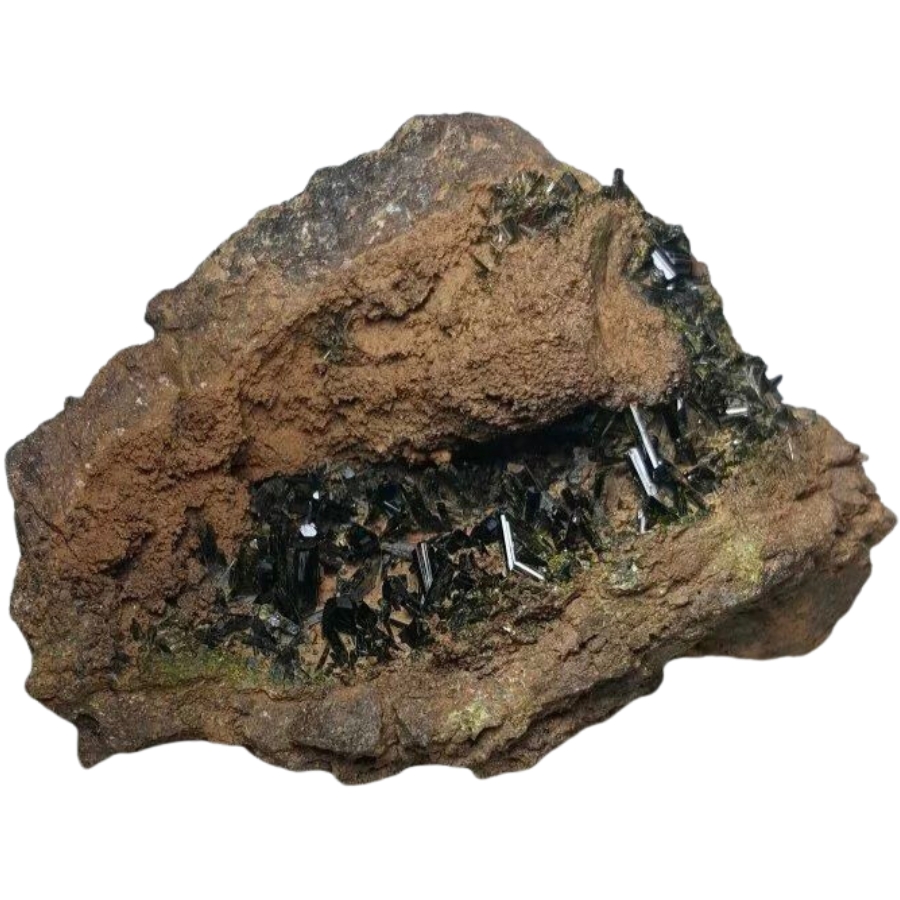
Epidote geodes contain usually dark, olive green colored crystals. Uncovering one is like discovering a secret patch of moss or leaves, with each one showing off shades of green that seem to whisper of ancient woods.
Epidote often grows where there are changes in temperature and pressure. As rocks change and shift, the right conditions are made for them to form.
Its name comes from the Greek word ‘epidosis,’ which means ‘increase.’ It’s because the mineral’s crystal faces often have one side longer than the other, making it look like it’s growing or increasing.
What makes epidote geodes so distinct is their color and the way the crystals group together. They often grow in long, thin shapes that cluster like a bunch of needles or blades. This unique appearance is one reason why they’re so valued.
Where you can find epidote geode
Epidote geodes are usually found in places that have a lot of activity under the ground, like where tectonic plates meet. This means they’re often discovered in mountain ranges and areas with lots of old, changing rocks.
Countries like Norway, Austria, and the USA, especially in Alaska, are known for their beautiful epidote specimens.
Hematite Geode
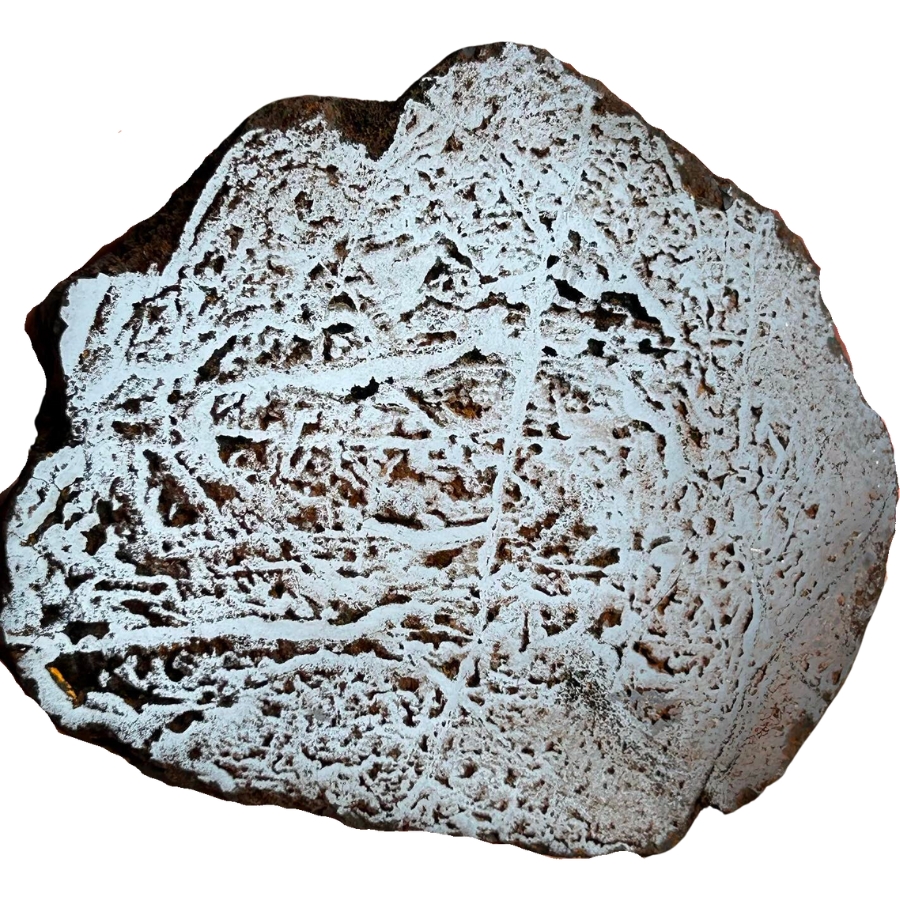
Hematite geodes are like holding a piece of the night sky in your hands, with their shiny, metallic surface that reflects light like stars.
The crystal hematite starts with iron-rich water seeping into the ground. As it moves and reacts with oxygen, it leaves behind the iron, which slowly turns into hematite.
The value of hematite geode comes from its crystals’ striking appearance and history. Its shiny surface has drawn people for centuries, so it’s used in jewelry, as a pigment for paint, and even for protection in battle.
The dark, metallic color of hematite is so unique, it’s been a symbol of strength and courage for a long time. Not only that— it’s the main ore of iron, which means it’s where most of the iron we use comes from.
Where you can find hematite geode
Hematite geodes are found in places with lots of iron, such as in Brazil. They can also be found in Australia and the USA, specifically in Michigan and Minnesota.

